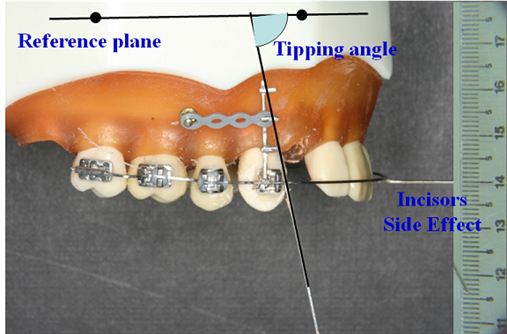Orthodontic Science and Practice Volume 5 – Número 19 – Ano 2012 Artigo Original/Original Article Página 301-309 Controle mecânico durante retração de dentes anteriores usando mini-implantes ortodônticos como ancoragem. Mechanical control during retraction of anterior teeth using orthodontic mini-implants as anchorage. Antônio Carlos de Oliveira Ruellas Cláudia Trindade Mattos Carlos Nelson Elias Resumo O objetivo foi avaliar o movimento do canino quando submetido à força aplicada em diferentes pontos de um gancho soldado na aleta distocervical e o efeito colateral nos incisivos, além de discutir a aplicação clínica. Foram avaliadas quatro opções de altura de inserção do elástico em cadeia, apoiado em mini-implante: próprio bráquete do canino; gancho, 5 mmm oclusal em relação ao MI; mesmo nível do MI; 5 mm apical em relação ao MI. O arco para a retração tinha um cursor soldado na linha média, para marcar a alteração vertical dos incisivos. Resultados foram estatisticamente analisados usando one-way ANOVA com post-hoc de Tukey. Houve diferença estatística entre as quatro opções de inserção de elástico tanto para a inclinação do canino como para o efeito vertical nos incisivos. À medida que a inserção do elástico aproxima-se do bráquete, o movimento resultante tende a ser de tip back do canino com extrusão dos incisivos. Por outro lado, à medida que se afasta do bráquete, o movimento tende a ser de tip forward do canino e intrusão dos incisivos. Conclui-se que é possível retrair canino com movimento de translação, quando apoiado em MI, podendo exercer efeito vertical nos incisivos. Descritores: mini-implantes, biomecânica, fechamento de espaço. Abstract To assess the movement of the canine when submitted to force applied in different points of a hook soldered to the distocervical wing of its bracket and the collateral effect on the incisors, besides discussing the clinical application. Methods: Four height options for insertion of the elastomeric chain supported by a mini-implant (MI) to retract the canine were assessed: (1) on the bracket itself; or on the hook soldered to the bracket – (2) 5 mm occlusal to the level of the mini-implant; (3) on the same level of the mini-implant; and (4) 5 mm apical to the level of the mini-implant. The archwire used for retraction had a cursor soldered to its midline to show alterations in the vertical position of the incisors. Results were statistically analyzed using one-way ANOVA with the Tukey HSD post-hoc test. Results: There were statistically significant differences among all groups both in the inclination of the canine and in the vertical effect on the incisors. The more occlusal the hook is in relation to the MI, the greater the effect of tip-back on the canine and extrusion on the incisors will be. The more apical the hook is in relation to the MI, the greater the effects of tip-forward on the canine and intrusion on the incisors will be. Conclusions: It is possible to retract the canine with a translation movement supported by MIs. These mechanics may cause a vertical effect on the incisors. Descriptors: mini-implants, biomechanics, space closure
Este contenido está restringido a los miembros del sitio. Si eres un usuario existente, por favor, accede. Los nuevos usuarios pueden registrarse a continuación.




